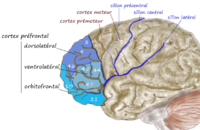
Photo from wikipedia
BACKGROUND Psychosocial stressors characterized by social threat, such as interpersonal loss and social rejection, are associated with depression in adolescents. Few studies, however, have examined whether social threat affects fronto-cingulate-limbic… Click to show full abstract
BACKGROUND Psychosocial stressors characterized by social threat, such as interpersonal loss and social rejection, are associated with depression in adolescents. Few studies, however, have examined whether social threat affects fronto-cingulate-limbic systems implicated in adolescent depression. METHODS We assessed lifetime stressor severity across several domains using the Stress and Adversity Inventory (STRAIN) in 57 depressed adolescents (16.15 ± 1.32 years, 34 females), and examined whether the severity of social threat and non-social threat stressors was associated with gray matter volumes (GMVs) in the anterior cingulate cortex (ACC), amygdala, hippocampus, and nucleus accumbens (NAcc). We also examined how lifetime social threat severity and GMVs in these regions related to depressive symptoms at baseline and over 9 months. RESULTS General stressor severity was related to greater depression severity at baseline and over 9 months. Moreover, greater severity of social threat (but not non-social threat) stressors was associated with smaller bilateral amygdala and NAcc GMVs, and smaller bilateral surface areas of caudal and rostral ACC (all pFDR ⩽ 0.048). However, neither social threat nor non-social threat stressor severity was related to hippocampal GMVs (all pFDR ⩾ 0.318). All fronto-cingulate-limbic structures that were associated with the severity of social threat were negatively associated with greater depression severity over 9 months (all pFDR ⩽ 0.014). Post-hoc analyses suggested that gray matter morphometry of bilateral amygdala, NAcc, and rostral and caudal ACC mediated the association between social threat and depression severity in adolescents over 9 months (all pFDR < 0.048). CONCLUSIONS Social threat specifically affects fronto-cingulate-limbic pathways that contribute to the maintenance of depression in adolescents.
Journal Title: Psychological medicine
Year Published: 2022
Link to full text (if available)
Share on Social Media: Sign Up to like & get
recommendations!